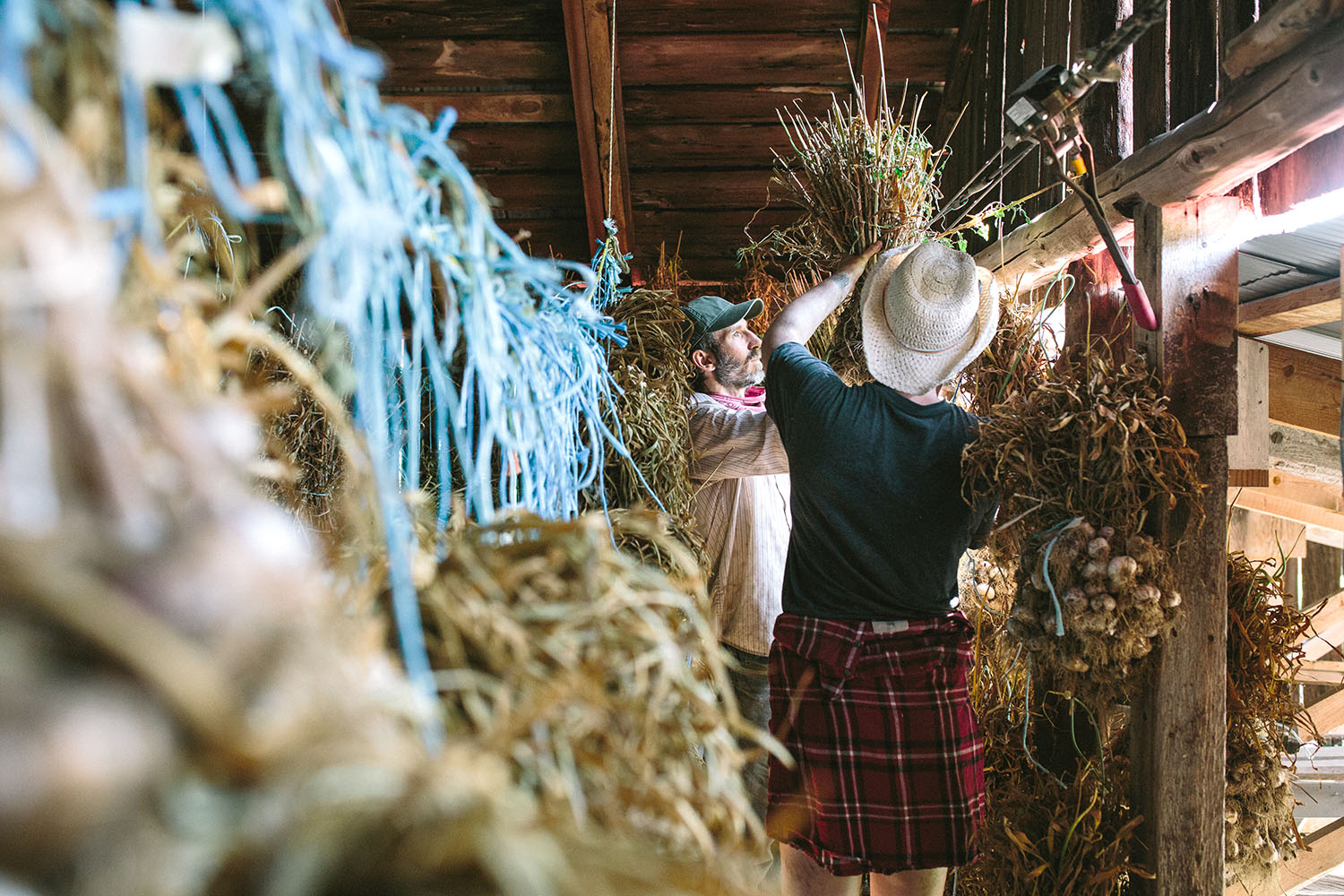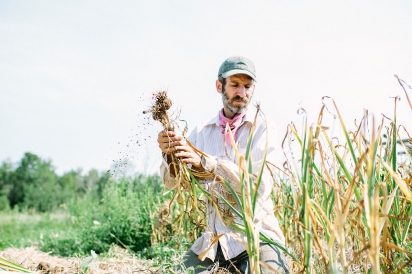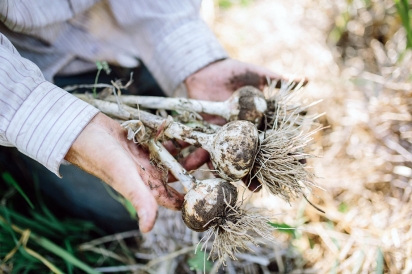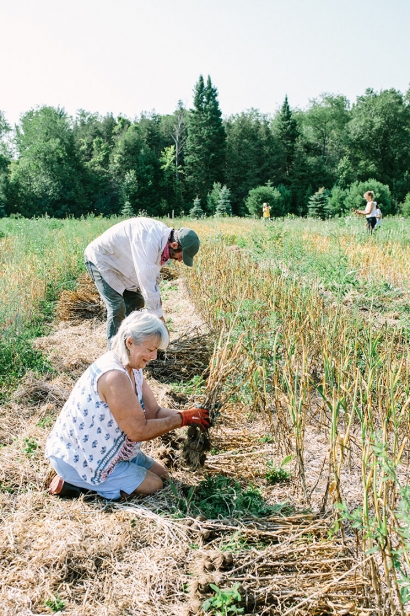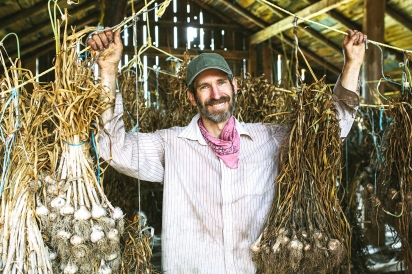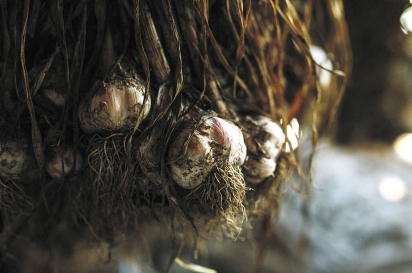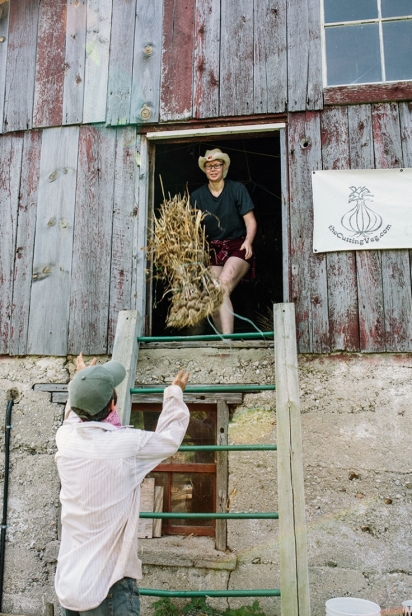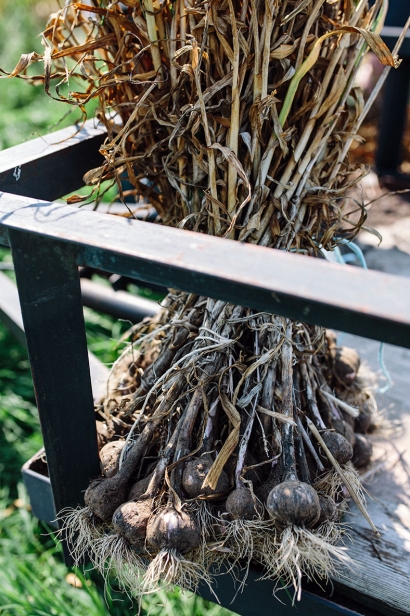Worldly Garlic
Organic vegetable farmer and social worker Daniel Hoffmann has “an insatiable passion.” He’s smitten by garlic. “I’m not even sure why,” the 43-year-old admits.
He thinks about garlic, running through the varied colours and smooth shapes of the bulbs, the health benefits and powerfully delicious taste.
He even loves the math behind seeing a single clove produce seed garlic that keeps doubling, doubling and doubling again, on to garlic infinity.
Hoffmann’s fascination with the delicious “stinking rose” fuels his dedication to the Global Garlic Project, which he launched in 2005.
Each year, he grows 40,000 to 50,000 garlic bulbs from all over the world on leased land as part of the Elmgrove Organic Farm Collective, near Sutton, about an hour due north of Toronto.
His aim with the Global Garlic Project is to grow and harvest a wide range of organic garlic types, promoting seed diversity, while introducing consumers to the different flavours inherent in each variety, from sweet to spicy-hot.
The crop keeps Hoffmann happy year-round. He pulls scallion-like, tender green garlic from the spring soil to flavour dishes. Early summer brings the tall, gentle curving seed pods called scapes. Cutting these helps the garlic grow strong and, once in hand, they’re delicious in salad dressings and cooking.
“I have garlic 12 months of the year — and I haven’t bought a bulb in 20 years,” he says.
Hoffmann’s goal is for more Canadians to be able to make the same boast. He wants people to grow garlic and his company, The Cutting Veg, focuses on showing them how.
Growing vegetables takes work and farming requires even more. Volunteers are crucial to keeping the Global Garlic Project running, as well as the rest of the Elmgrove Organic Farm. Helpers show up each weekend for mulching, weeding and other chores.
They’re most needed in August, to help with the harvest. In October, over Thanksgiving weekend, volunteers return to plant seed garlic.
Hoffmann’s wife Terri Segal, whose company Rhythmic by Nature does group drumming workshops, adds inspiration to the labours of harvesting and planting with 10 to 15 drummers.
After the garlic is harvested, it goes into the barn for about a month to dry. About 2,000 of the best heads are used for seed cloves.
Hoffman started farming at Elmgrove Farm in 2011, and by 2013 he had helped create the Elmgrove Organic Farm Collective, composed of a handful of farmers who work on leased plots and run small food businesses. All the Elmgrove Organic Farm Collective members started farming through Hoffman’s internship program, except the landowners and the beekeeper.
It’s part of his work around community agriculture, including garden coaching and helping establish organic community gardens in condos and apartments in the Greater Toronto Area. The Backyard Farm and Farmers Market at Erin Mills is one such project, a non-profit community-led initiative that offers local food and urban agricultural experiences in Mississauga.
“I was motivated to be of service to the world and I found being a farmer a fantastic way to do that,” he says.
Hoffman has about 1.5 acres under cultivation each year at Elmgrove. Half of the land is used for organic veggies including green onions, salad mix and rhubarb for non-profit Foodshare and farm-to-table box programs such as Fresh City Farms. The rest is dedicated to the flavour-packed vegetable dearest to his heart.
Hoffman started the Global Garlic Project with 100 bulbs, 10 each of Persian, Sicilian, Russian, Italian, Korean, Salt Spring Island, Ukrainian, Former Yugoslavian, Thai and Tibetan seed garlic from Salt Spring Seeds. “I was like, wow, there’s more than one variety of garlic?” Hoffmann recalls of his beginnings.
He now has 23 varieties — and that number is growing. Not all succeed, but most do because garlic grows just about anywhere. And he has the patience to establish seed and yield crops, sharing and selling the harvests through his Cutting Veg website and at the Toronto Garlic Festival in September, alongside other growers producing a variety of organic and naturally grown garlic.
Turns out there’s a whole world of garlic out there beyond the stuff at the grocery store bins.
Our typical, non-organic supermarket staple often comes from China, which produces about two-thirds of the world’s garlic.Hoffman hopes the Global Garlic Project will change the garlic supply chain by encouraging new growers, both farmers and gardeners. Seed garlic is easy to share. And, in Hoffman’s telling, easy to love.
Purple Cuban is gorgeous, Hoffmann says. And he makes French Rose de Lautrec’s “stunning pink cloves” sound practically sonnet-worthy.
Besides cooking with garlic, Hoffmann likes to use a food dehydrator to make garlic powder and a rice cooker to make caramelized black garlic.
“Even my five-year-old loves it and calls it black licorice,” he says of the super-mild, sweet result.
It takes about 11 days at very low heat in a rice cooker to make the inky black garlic, which Hoffmann says is “medically more beneficial” than raw garlic.
To maximize garlic’s health benefits, Hoffmann puts his organic raw cloves through a garlic press to release the wholesome allicin. He lets it sit for 10 minutes to get the most out of his garlic. “I believe it has a really positive impact on keeping my family healthy,” he says.
His favourite way to eat garlic is raw, in salad dressings. Hoffmann tends to double up when he cooks with it to get “extra garlic yumminess.”
He chops onions and garlic and sautées them in oil to start the dish, then adds the pressed raw garlic when cooking is finished, “for extra flavour and spiciness and that signature garlic stink.”
Speaking of stink, what about garlic breath? Hoffmann says that, while raw garlic can be a problem for some people, “brush your teeth and you’re good to go.”
Always thrilled to discover a new garlic, Hoffmann remembers driving past a nearby field and spotting an unfamiliar garlic tended by an octogenarian farmer. He stopped and spoke to the man, who turned out to be a Sicilian who’d brought the garlic along when he immigrated 30 or 40 years before.“
That fall, I brought him 10 of my varieties and he gave me some of his,” Hoffmann says. The new addition is being grown at Elmgrove now.
One day, garlic lovers will be able to taste it for themselves and go on to grow it, when the first crop of Charlie’s Sicilian — named after the farmer — is harvested and joins the Global Garlic Project.”
The Cutting Veg
thecuttingveg.com | 647.388.7444 | @thecuttingvegto


